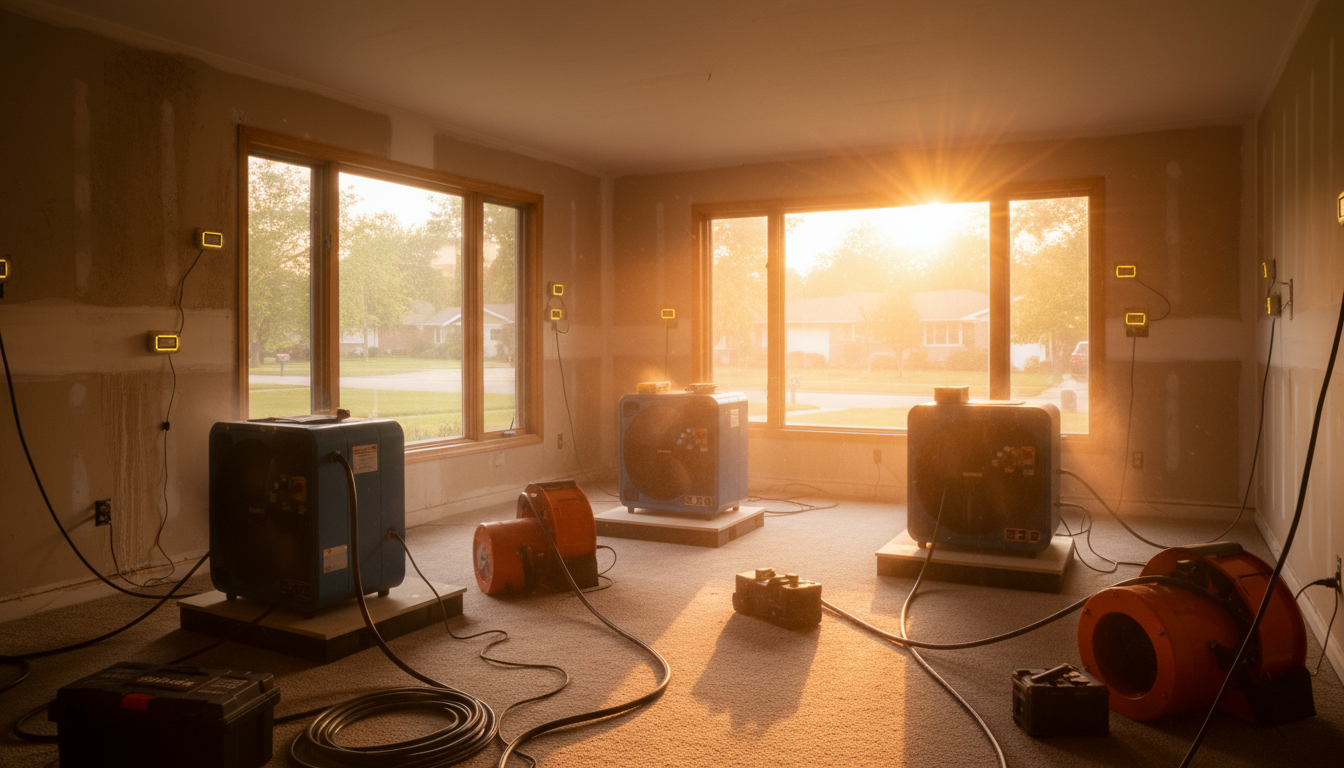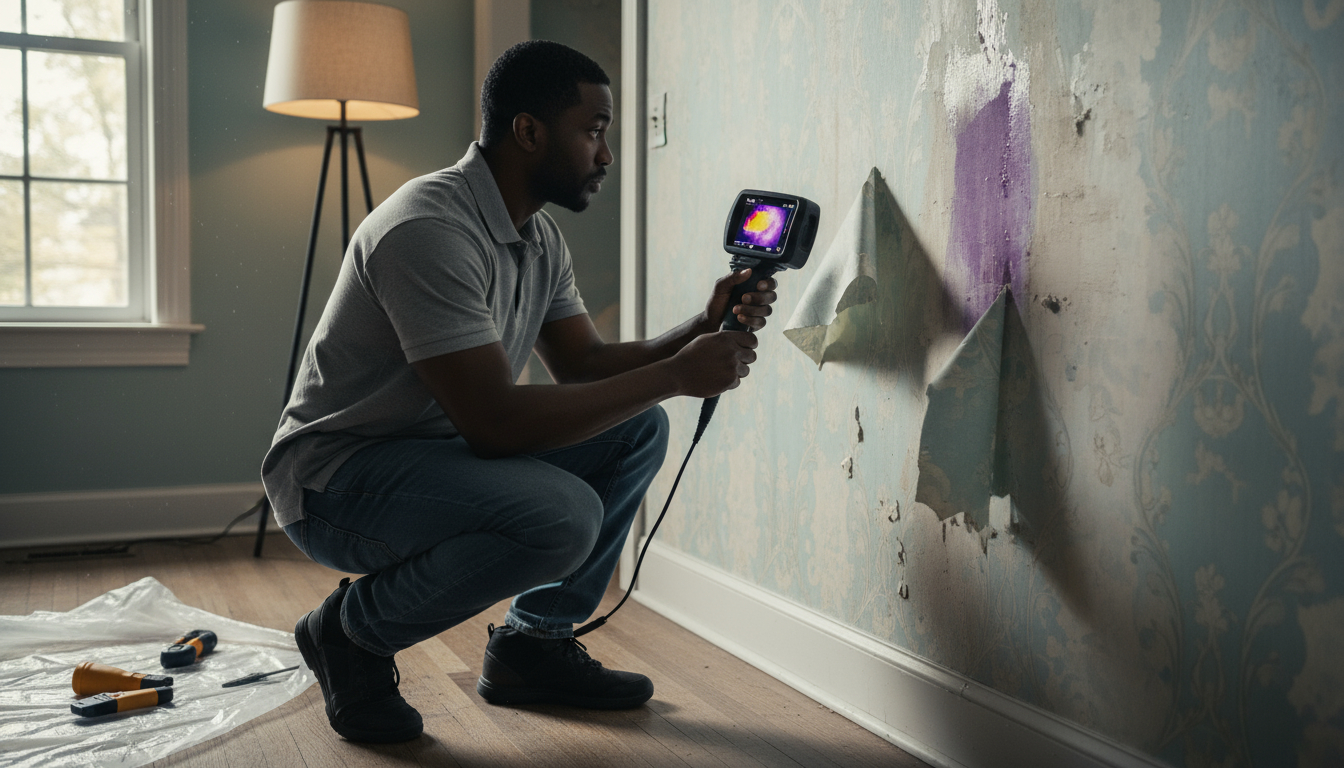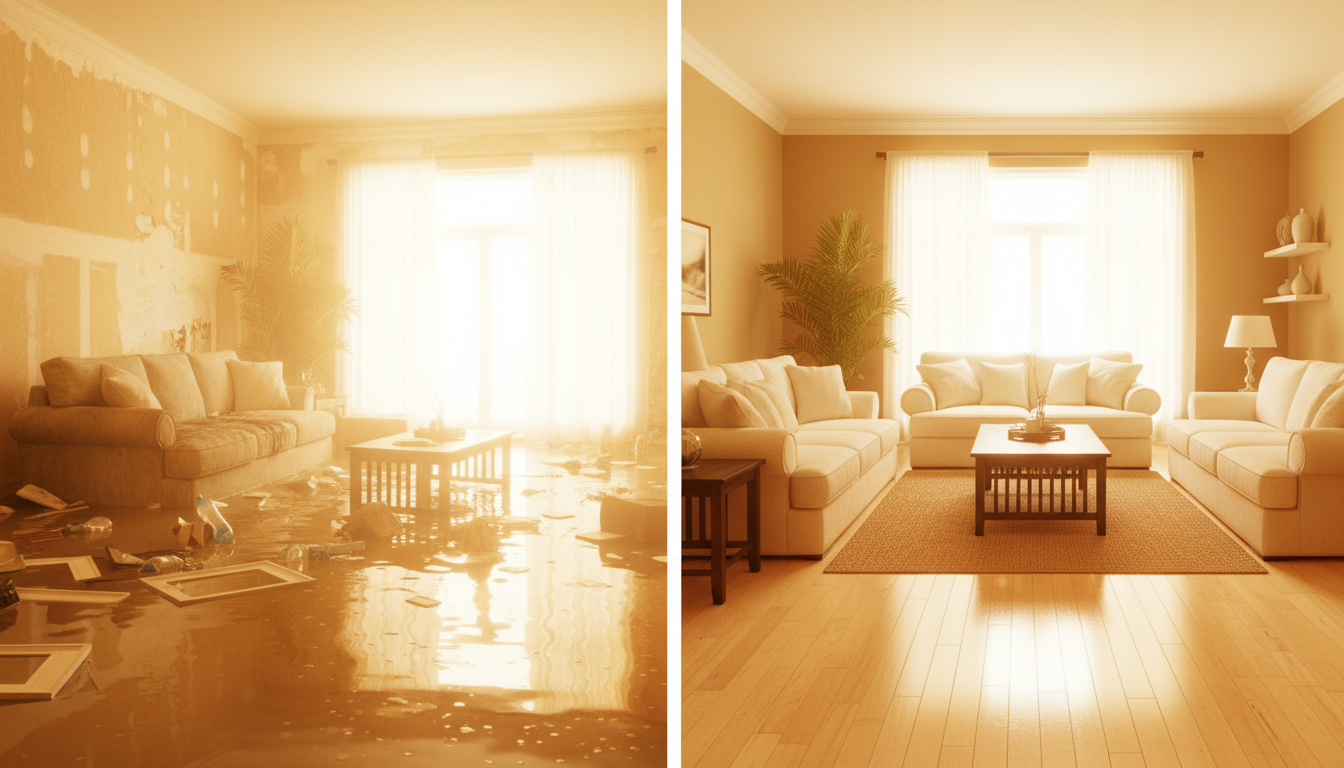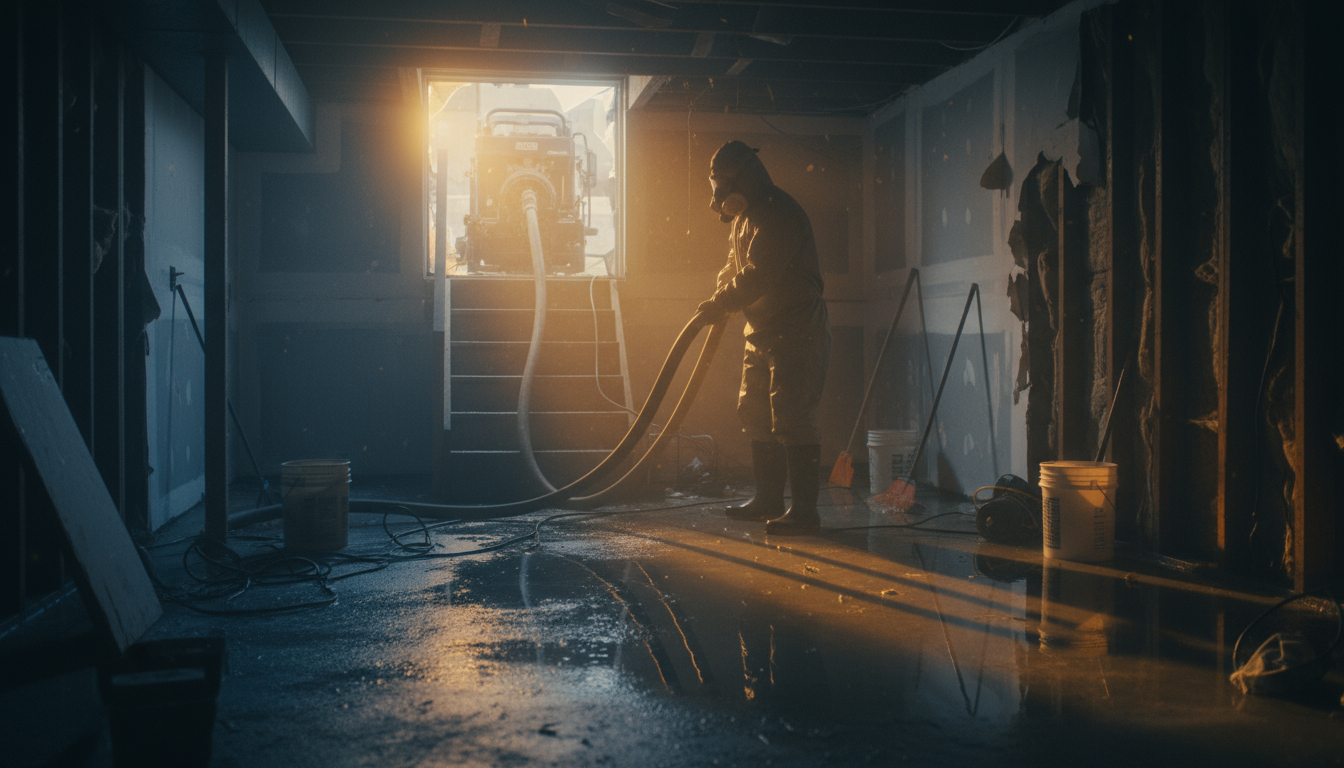What is Flood Damage Restoration?
Flood damage restoration encompasses the complete process of returning a water-damaged property to its pre-loss condition following flooding events. This specialized service goes far beyond simple water removal, addressing contamination concerns, structural integrity, moisture management, and environmental safety through scientifically-proven drying protocols.
Professional flood recovery involves multiple coordinated phases: emergency water extraction, contaminant mitigation, structural assessment, advanced drying techniques, antimicrobial treatment, and reconstruction services. Each phase of flood damage restoration requires specialized equipment, technical expertise, and strict adherence to industry standards established by organizations like the Institute of Inspection, Cleaning and Restoration Certification.
Unlike routine water damage from clean sources, flood damage restoration must address contamination from sewage, chemicals, debris, and biological hazards that floodwaters typically carry. This makes professional intervention essential rather than optional, as improper handling creates serious health risks and long-term structural problems. For comprehensive assistance, Advanced DRI offers 24/7 emergency restoration services throughout the Hudson Valley region.
Categories of Flood Water Contamination
Understanding water contamination levels helps property owners recognize the severity of their situation and the appropriate flood damage restoration response protocols. Restoration professionals classify floodwater into three distinct categories based on contamination level and health risks.
| Category | Description | Sources | Health Risk |
|---|---|---|---|
| Category 1 | Clean water from sanitary sources | Supply lines, rainwater, melting snow | Minimal when fresh |
| Category 2 | Gray water with contaminants | Washing machines, dishwashers, toilet overflow (no feces) | Moderate discomfort or illness |
| Category 3 | Black water—grossly contaminated | Sewage, flooding from rivers/streams, standing water | Severe illness or death |
Most flood damage restoration projects involve Category 3 water, which requires the most aggressive treatment protocols. Even Category 1 water can degrade to Category 2 or 3 within 48 hours as it contacts building materials and begins supporting microbial growth.
⚠️ Important: Never assume floodwater is safe to handle. All flooding from external sources should be treated as Category 3 contamination, requiring professional protective equipment and specialized flood cleanup protocols. If you’re dealing with sewage contamination, our team provides specialized residential sewage cleanup services.
How the Flood Damage Restoration Process Works
Professional flood cleanup follows a systematic approach designed to maximize recovery while minimizing health risks and secondary damage. The flood damage restoration process typically spans several days to weeks depending on damage severity and property size.
Phase 1: Emergency Response and Assessment (Hours 0-24)
Flood damage restoration teams arrive quickly to stop ongoing damage and evaluate the situation. Technicians conduct moisture mapping using thermal imaging cameras and moisture meters to identify all affected areas, including hidden water behind walls and under flooring. They document damage extensively for insurance purposes and develop a comprehensive restoration plan.
Safety assessment is paramount during initial response. Professionals check for structural hazards, electrical dangers, contamination levels, and environmental threats before beginning extraction. This phase also includes emergency board-up services if needed to secure the property.
Phase 2: Water Extraction (Hours 24-48)
Removing standing water quickly prevents additional absorption into porous materials and reduces drying time significantly. Professional flood water removal equipment includes:
- Truck-mounted extractors that remove thousands of gallons per hour
- Submersible pumps for deep standing water in basements
- Wet vacuums for detailed extraction in tight spaces
- Portable extractors for carpets and upholstery
Technicians extract water methodically during the flood cleanup process, working from highest to lowest elevations and paying special attention to areas where water accumulates. Complete extraction may require multiple passes with different equipment types to remove water from various materials and locations. For properties in New York, our residential water cleanup services provide rapid response throughout the region.
💡 Pro Tip: The first 48 hours after flooding are critical. Water extraction during this window dramatically reduces the likelihood of permanent damage and mold development.
Phase 3: Contaminant Removal and Cleaning (Days 2-4)
Flood water carries sediment, sewage, chemicals, and biological contaminants that require thorough removal before drying can proceed. Flood damage restoration professionals use EPA-registered antimicrobial solutions and specialized cleaning techniques appropriate for each surface type.
This phase includes removing contaminated porous materials that cannot be effectively cleaned, such as drywall that contacted Category 3 water, insulation that remained saturated, and carpeting that absorbed sewage. Non-porous surfaces undergo thorough cleaning and disinfection using hospital-grade solutions. Our biohazard cleanup services ensure complete decontamination of affected areas.
Phase 4: Structural Drying (Days 3-14)
The most technically complex phase of flood damage restoration involves removing moisture from building materials using industrial dehumidifiers, air movers, and specialized drying equipment. Technicians create optimal drying conditions by controlling temperature, humidity, and airflow throughout the affected area.
Professional drying equipment includes:
- Low-grain refrigerant (LGR) dehumidifiers that remove moisture even in cold conditions
- Desiccant dehumidifiers for specialized drying situations
- High-velocity air movers that accelerate evaporation rates
- Injectidry systems that dry wall cavities and subfloors
Technicians monitor moisture levels daily using specialized meters, adjusting equipment placement and settings based on drying progress. The drying phase continues until all materials reach industry-standard dry goals, typically 12-15% moisture content for wood materials.

Phase 5: Reconstruction and Restoration (Days 7-30+)
Once structures are completely dry, flood damage restoration reconstruction begins to return the property to pre-loss condition. This may involve replacing drywall, installing new flooring, repainting, and rebuilding damaged structural components. Comprehensive restoration includes both repairs and preventive measures to reduce future flood risks. Advanced DRI provides complete reconstruction services to restore your property fully.
The Science Behind Structural Drying
Effective flood recovery requires understanding psychrometrics—the science of air and moisture interaction. This knowledge allows flood damage restoration professionals to create optimal drying conditions that safely and efficiently remove moisture from building materials.
Drying occurs through evaporation when moisture moves from wet materials into the surrounding air. The rate of evaporation depends on several factors: temperature, relative humidity, airflow, and the moisture content difference between materials and air. Professional technicians manipulate these variables to maximize drying efficiency.
| Drying Factor | Professional Control Method | Impact on Drying Speed |
|---|---|---|
| Temperature | Climate control systems | Higher temps increase evaporation by 15-20% per 10°F |
| Humidity | Industrial dehumidifiers | Lower humidity creates greater moisture gradient |
| Airflow | Strategic air mover placement | Continuous air movement prevents saturation |
| Surface area | Removing non-salvageable materials | Greater exposure accelerates moisture release |
Dehumidifiers work by removing moisture from the air, lowering relative humidity and creating conditions where materials can release their moisture content. As materials dry, they release moisture into the air, which dehumidifiers capture and expel, creating a continuous drying cycle.
🏠 Home Tip: Never rely on opening windows for flood drying. Outdoor humidity often equals or exceeds indoor levels, preventing effective drying and potentially introducing more moisture into the structure.
Types of Flood Damage Restoration Services
Different flooding scenarios require specialized flood damage restoration approaches and expertise. Understanding these distinctions helps property owners communicate effectively with restoration companies and set appropriate expectations.
Residential Flood Cleanup
Home flood damage restoration focuses on living spaces, personal belongings, and maintaining habitability during the restoration process. Residential flood cleanup services emphasize salvaging sentimental items, coordinating with homeowners insurance, and minimizing disruption to families. Technicians pay special attention to bedrooms, bathrooms, kitchens, and finished basements where contamination risks are highest. Learn more about our residential restoration services.
Commercial Flood Recovery
Business property flood damage restoration requires rapid response to minimize operational downtime and revenue loss. Commercial flood recovery services include emergency document drying, electronics restoration, inventory salvage, and coordinated reconstruction that allows partial business operations during recovery. Large commercial projects may involve multiple crews working simultaneously across different areas. Our commercial restoration services help businesses return to normal operations quickly.
Storm Damage Restoration
Natural disaster flooding from hurricanes, severe storms, or rapid snowmelt presents unique challenges including widespread damage, extended power outages, and compromised municipal services. Storm flood damage restoration often involves roof tarping, temporary power solutions, and coordinating with FEMA and insurance adjusters familiar with catastrophic loss claims. Advanced DRI provides comprehensive wind and storm damage services.
Sewage Backup Cleanup
When flooding involves sewage or septic system backups, flood damage restoration requires additional safety protocols and specialized cleaning procedures. Sewage flood cleanup demands complete removal of contaminated materials, extensive antimicrobial treatment, and thorough deodorization to eliminate health hazards and persistent odors.
Timeline and Expectations for Flood Recovery
Understanding realistic timelines helps property owners plan appropriately and recognize quality flood damage restoration work. While every situation differs, most flood cleanup projects follow predictable phases with measurable milestones.
Immediate Response (0-4 hours): Emergency contact, initial assessment, and work authorization. Reputable flood damage restoration companies offer 24/7 emergency response and can typically arrive within 1-2 hours of initial contact.
Water Extraction (4-48 hours): Complete flood water removal using professional equipment. Extraction should begin immediately and continue until no visible water remains. This phase may extend longer for large commercial properties or severe flooding.
Drying Phase (3-14 days): Structural drying using industrial dehumidifiers and air movers. Most residential flood damage restoration projects achieve dry standards within 5-7 days, though severely saturated structures or unfavorable weather conditions may extend this timeline. Daily monitoring ensures progress and allows equipment adjustments.
Reconstruction (1-4 weeks): Rebuilding and restoration work to return property to pre-loss condition. Timeline varies significantly based on damage extent, material availability, and reconstruction scope. Simple drywall replacement may take days while extensive structural repairs require weeks.
⚠️ Important: Any company promising complete flood damage restoration in 24-48 hours likely cannot provide proper structural drying. Quality restoration requires time to ensure materials reach safe moisture levels.
Benefits of Professional Flood Damage Restoration
While the necessity of professional flood cleanup may seem obvious, understanding specific benefits helps property owners appreciate the value of expert intervention and avoid costly DIY mistakes.
Health and Safety Protection: Professional flood damage restoration technicians use appropriate personal protective equipment and follow strict safety protocols when handling contaminated floodwater. They understand which materials pose health risks and require disposal versus those that can be safely cleaned and restored.
Complete Moisture Removal: Hidden moisture behind walls, under flooring, and in building cavities causes long-term problems if not properly addressed during flood damage restoration. Professional moisture detection equipment identifies all affected areas, while industrial drying equipment ensures complete drying according to scientific standards.
Mold Prevention: Proper flood damage restoration prevents mold growth by removing moisture quickly and treating affected materials with antimicrobial solutions. Studies show that professional flood cleanup reduces mold development by over 85% compared to DIY approaches. If mold does develop, our mold removal services can address the problem.
Insurance Claim Support: Flood damage restoration companies document damage thoroughly, communicate directly with insurance adjusters, and provide detailed estimates that support claim approval. This expertise often results in higher settlement amounts and faster claim resolution.
Structural Integrity Preservation: Water weakens building materials, compromises structural components, and can cause foundation problems if not addressed properly. Professional flood damage restoration assessment identifies structural concerns early when repairs are simpler and less expensive.
Time and Cost Efficiency: While professional flood damage restoration requires upfront investment, it prevents costly secondary damage, reduces total restoration time, and typically results in lower overall costs compared to delayed or improper response.
Critical Factors in Successful Flood Recovery
Several key variables determine flood damage restoration outcomes and long-term success. Property owners should understand these factors when evaluating damage severity and restoration needs.
Response Speed
Time remains the single most critical factor in flood damage restoration outcomes. Water migration continues every minute, expanding affected areas and increasing damage severity. Microbial growth begins within 24-48 hours, while structural deterioration accelerates with prolonged exposure. Immediate professional flood cleanup response significantly improves recovery prospects.
Water Category and Contamination Level
Clean water damage requires different flood damage restoration protocols than grossly contaminated flood water. Category 3 contamination demands aggressive material removal, extensive antimicrobial treatment, and heightened safety precautions. Understanding contamination levels helps property owners recognize appropriate restoration approaches.
Material Porosity and Absorbency
Different building materials respond differently to water exposure. Non-porous materials like tile and metal resist water absorption and typically recover well with proper cleaning. Porous materials like drywall, insulation, and carpeting absorb water readily and often require replacement after severe flooding. Semi-porous materials like hardwood flooring may be salvageable depending on exposure duration and water category.
Climate and Environmental Conditions
Temperature, humidity, and ventilation affect flood damage restoration drying rates significantly. Favorable conditions accelerate restoration while unfavorable weather can extend timelines. Professional equipment creates optimal drying conditions regardless of outside weather, but natural conditions still play a role in overall efficiency.
💡 Pro Tip: Flood damage in humid climates or during wet seasons requires more aggressive dehumidification and longer drying periods compared to dry conditions. Don’t judge restoration progress solely by visible surface drying.
Common Flood Damage Problems and Solutions
Understanding typical complications helps property owners recognize issues early and communicate effectively with flood damage restoration professionals.

Hidden Moisture Behind Walls
Water travels through wall cavities, accumulating in insulation and creating hidden damage. Thermal imaging cameras detect temperature differences that indicate trapped moisture, while moisture meters measure material saturation levels. Flood damage restoration solutions include controlled demolition to access affected cavities and installing injection drying systems that force dry air into wall spaces.
Persistent Odors After Cleanup
Lingering odors typically indicate incomplete drying or contamination that wasn’t fully addressed during flood cleanup. Professional odor control involves identifying the source, ensuring complete drying, and using specialized treatments like hydroxyl generators or ozone machines that neutralize odor molecules rather than masking them.
Secondary Water Damage
Initial flood damage can cause additional problems including ceiling collapse from saturated materials, warped hardwood floors from prolonged exposure, and electrical system damage from moisture infiltration. Comprehensive flood damage restoration assessment identifies all damage, including secondary effects, before restoration planning begins.
Mold Growth After Restoration
Mold appearing weeks after flood damage restoration completion typically results from incomplete drying, hidden moisture that wasn’t detected, or insufficient antimicrobial treatment. Quality restoration includes verification of dry standards and preventive treatment that makes mold growth unlikely when proper protocols are followed.
Prevention and Long-Term Protection Strategies
While not all flooding is preventable, property owners can take steps to reduce risks and minimize damage severity when flooding occurs, potentially avoiding extensive flood damage restoration needs.
Install flood sensors and alarms: Modern water detection systems alert property owners immediately when flooding begins, enabling faster response and reducing damage extent. Smart sensors can send notifications to smartphones even when occupants are away from the property.
Maintain proper grading and drainage: Ensure ground slopes away from the foundation and gutters direct water at least 6 feet from the structure. Poor drainage creates hydrostatic pressure against foundations and increases flooding risk during heavy rainfall.
Install backwater valves: These one-way valves prevent sewage backup when municipal systems become overwhelmed during flooding events. Installation typically requires professional plumbing work but provides significant protection against Category 3 contamination.
Elevate mechanical systems: Place HVAC equipment, water heaters, and electrical panels above flood-prone areas when possible. Elevation reduces equipment damage and maintains essential services during minor flooding events.
Create emergency response plans: Know how to shut off electricity, water, and gas quickly. Keep emergency contact numbers accessible and understand your insurance coverage before flooding occurs. Preparedness enables faster, more effective response when disaster strikes. Learn more about disaster planning services to protect your property.
🏠 Home Tip: Take photos and video of your property and belongings before flooding occurs. This documentation proves pre-loss condition and streamlines insurance claims significantly.
Investment Considerations in Flood Damage Restoration
Several factors influence the investment required for flood damage restoration and flood recovery. Understanding these variables helps property owners set realistic expectations and make informed decisions.
Damage extent and affected area: Square footage and the number of affected rooms represent the primary factors influencing flood damage restoration scope. Larger projects require more equipment, longer timelines, and additional labor, naturally increasing overall investment.
Water category and contamination level: Category 3 flood damage requires more extensive material removal, aggressive antimicrobial treatment, and heightened safety protocols compared to clean water damage. Contamination increases both material and labor requirements significantly.
Material types and finishes: Hardwood flooring, custom cabinetry, and specialty materials require more careful handling and specialized restoration techniques. Standard materials with simpler finishes typically restore more economically.
Structural impact: Flooding that compromises structural integrity, affects foundation systems, or requires extensive reconstruction naturally requires greater investment than surface-level damage. Early professional flood damage restoration assessment helps identify structural concerns before they escalate.
Insurance coverage and deductibles: Most homeowners and commercial property policies include flood-related coverage, though separate flood insurance may be required in high-risk areas. Understanding coverage details and deductible amounts helps property owners plan financially for restoration needs. Advanced DRI can help with financing options if needed.
⚠️ Important: Attempting DIY flood cleanup to save money typically results in incomplete restoration, hidden damage, and eventual mold problems that cost significantly more to address than proper initial flood damage restoration would have required.
Why Professional Expertise Matters in Flood Recovery
The complexity of proper flood damage restoration exceeds what typical property owners can accomplish with rental equipment and basic supplies. Professional expertise provides several critical advantages that protect both immediate recovery and long-term property value.
Flood damage restoration professionals understand building science, moisture dynamics, and structural systems in ways that enable comprehensive damage assessment and appropriate repair planning. They recognize which materials can be saved versus those requiring replacement, and they understand how water migrates through different building assemblies.
Advanced equipment makes professional flood damage restoration more effective than DIY approaches. Industrial dehumidifiers remove 10-20 times more moisture than consumer units, while moisture detection technology identifies hidden damage that visual inspection misses. Professional-grade antimicrobial treatments provide protection that household cleaners cannot match.
Experience with insurance processes helps maximize claim settlements and accelerate approval timelines. Flood damage restoration companies document damage thoroughly, provide detailed estimates that meet insurance requirements, and communicate directly with adjusters using terminology and standards they recognize and accept.
💡 Pro Tip: Choose flood damage restoration companies that employ technicians with industry training and maintain comprehensive insurance coverage. Quality companies invest in ongoing education and carry both liability insurance and workers compensation to protect property owners.

Frequently Asked Questions
How quickly should I respond to flood damage?
Immediate response is critical for successful flood recovery. Contact professional flood damage restoration services within the first hour if possible, as water extraction should begin within 24 hours to prevent extensive secondary damage and mold growth. Every hour of delay allows water to migrate further into building materials, increases contamination risks, and reduces the likelihood of salvaging affected materials.
Can I handle flood cleanup myself or do I need professionals?
Professional flood damage restoration is strongly recommended and often essential, particularly for Category 3 contaminated water. Professionals have specialized equipment for complete moisture removal, understand safety protocols for contaminated water handling, and can detect hidden moisture that causes long-term problems. DIY approaches typically result in incomplete drying, hidden damage, and eventual mold problems that cost significantly more to address than proper initial flood damage restoration.
How long does complete flood damage restoration take?
Typical flood damage restoration takes 1-3 weeks from initial water extraction through final reconstruction, though timelines vary based on damage severity and property size. Water extraction requires 1-2 days, structural drying takes 5-14 days, and reconstruction spans several days to weeks. Severely damaged properties or large commercial spaces may require extended timelines, while minor flooding in small areas may complete more quickly.
What are the signs my property has hidden flood damage?
Warning signs of hidden flood damage include persistent musty odors, visible mold growth on walls or ceilings, warping or buckling of floors and baseboards, peeling paint or wallpaper, water stains that continue expanding, and increased humidity levels indoors. You might also notice soft or spongy spots in floors and walls, separated seams in flooring materials, or rust on metal fixtures. Professional moisture detection equipment can identify hidden damage that visual inspection misses.
Will my homeowners insurance cover flood damage restoration?
Standard homeowners insurance typically covers sudden and accidental water damage like burst pipes but often excludes flood damage from external sources. Properties in flood-prone areas usually require separate flood insurance through the National Flood Insurance Program or private insurers. Review your specific policy or contact your insurance agent to understand your coverage. Professional flood damage restoration companies can help document damage appropriately and communicate with insurance adjusters to support your claim.
How can I prevent mold growth after flooding?
Mold prevention after flooding requires rapid water removal within 24-48 hours, complete structural drying using professional dehumidifiers, removal of contaminated porous materials that cannot be properly cleaned, and antimicrobial treatment of all affected surfaces. Maintain indoor humidity below 60% during drying, ensure good ventilation throughout the property, and verify that all materials reach proper dry standards before reconstruction begins. Professional flood damage restoration companies follow protocols specifically designed to prevent mold development.
Trust Advanced DRI for Complete Flood Damage Restoration
When flooding strikes your Hudson Valley property, Advanced DRI provides the comprehensive flood damage restoration expertise you need for complete recovery. Our experienced team responds 24/7 to emergencies throughout the region, arriving quickly with industrial-grade equipment and the technical knowledge to handle even the most severe flood damage. We serve properties across the Hudson Valley, northern New Jersey, Pennsylvania capital region, and Connecticut.
We understand the stress and disruption that flooding causes for families and businesses. That’s why we coordinate every aspect of flood damage restoration—from initial water extraction through final reconstruction—while keeping you informed throughout the process. Our technicians work directly with your insurance company to streamline claims and ensure you receive appropriate coverage for restoration needs.
Don’t let flood damage compromise your property’s safety, value, or habitability. Contact Advanced DRI immediately for emergency flood damage restoration and flood cleanup services. Our rapid response team is standing by to protect your property and guide you through complete flood recovery. Call us now for 24/7 emergency service or schedule a comprehensive flood damage assessment.

